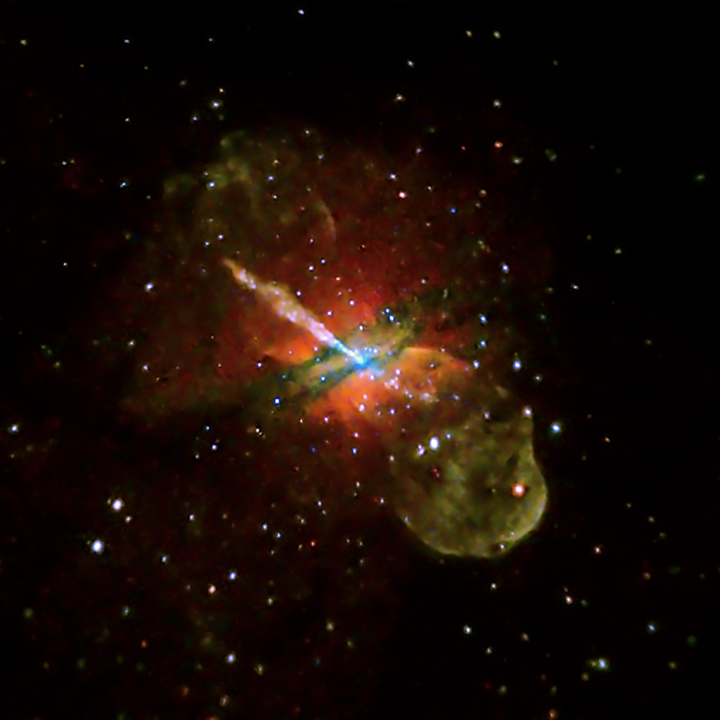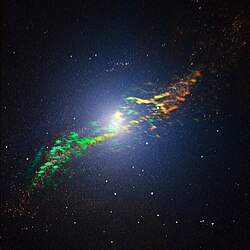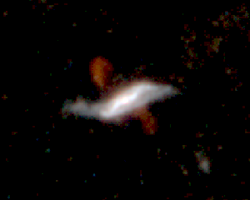Centaurus A Chandra
The image was made from an ultra-deep look at the galaxy Centaurus A, equivalent to more than seven days of continuous observations. Centaurus A is the nearest galaxy to Earth that contains a supermassive black hole actively powering a jet.
A prominent X-ray jet extending for 13,000 light years points to the upper left in the image, with a shorter "counterjet" aimed in the opposite direction. Astronomers think that such jets are important vehicles for transporting energy from the black hole to the much larger dimensions of a galaxy, and affecting the rate at which stars form there.
High-energy electrons spiraling around magnetic field lines produce the X-ray emission from the jet and counterjet. This emission quickly saps the energy from the electrons, so they must be continually reaccelerated or the X-rays will fade out. Knot-like features in the jets detected in the Chandra image show where the acceleration of particles to high energies is currently occurring, and provides important clues to understanding the process that accelerates the electrons to near-light speeds.
The inner part of the X-ray jet close to the black hole is dominated by these knots of X-ray emission, which probably come from shock waves -- akin to sonic booms -- caused by the jet. Farther from the black hole there is more diffuse X-ray emission in the jet. The cause of particle acceleration in this part of the jet is unknown.
Hundreds of point-like sources are also seen in the Chandra image. Many of these are X-ray binaries that contain a stellar-mass black hole and a companion star in orbit around one another. Determining the population and properties of these black holes should help scientists better understand the evolution of massive stars and the formation of black holes.
Another surprise was the detection of two particularly bright X-ray binaries. These sources may contain stellar mass black holes that are unusually massive, and this Chandra observation might have caught them gobbling up material at a high rate.
In this image, low-energy X-rays are colored red, intermediate-energy X-rays are green, and the highest-energy X-rays detected by Chandra are blue. The dark green and blue bands running almost perpendicular to the jet are dust lanes that absorb X-rays. This dust lane was created when Centaurus A merged with another galaxy perhaps 100 million years ago.Relevante Bilder
Relevante Artikel
Centaurus ACentaurus A ist die Bezeichnung einer Galaxie im Sternbild Centaurus. NGC 5128 ist eine starke Radioquelle. NGC 5128 hat eine Winkelausdehnung von 25,7′ × 20,0′ und eine scheinbare Helligkeit von 6,6 mag. Centaurus A gehört damit neben der etwa gleich hellen Galaxie Messier 81 zu den scheinbar hellsten Galaxien außerhalb der Lokalen Gruppe und damit zur Gruppe der hellsten extragalaktischen Objekte am Himmel. Die Entfernungsangaben liegen zwischen 10 und 17 Millionen Lichtjahren. Sie ist Teil der M83-Gruppe. Sie ist die nächstgelegene Radiogalaxie und die dritthellste Radioquelle am Himmel. Unter den Experten herrscht nach wie vor Uneinigkeit über ihren morphologischen Typ, wobei ein Teil der Forscher sie als elliptische Galaxie vom Typ E(p), ein anderer Teil als linsenförmige Galaxie vom Typ S0 klassifiziert. Ihr charakteristisches optisches Merkmal ist dabei das deutlich sichtbare Staubband, das die Galaxie durchquert. Außerdem ist sie eine starke Quelle von Röntgen- und Gammastrahlung. Aus dem Kern heraus wird ein relativistischer Jet emittiert. Durch ihre Nähe ist sie eine der am besten untersuchten aktiven Galaxien. Im Zentrum wird ein Schwarzes Loch mit einer Masse von 55 Millionen Sonnenmassen vermutet. Die ungewöhnliche Aktivität von Centaurus A lässt sich dadurch erklären, dass sie vor einigen 100 Millionen Jahren eine Kollision mit einer kleinen Spiralgalaxie hatte und diese vollständig aufnahm. Dadurch gab es eine heftige Sternentstehungsphase. Zudem wurden Gasmassen aus ihren ursprünglichen Bahnen abgelenkt und sammelten sich teilweise um das Schwarze Loch im Zentrum an. .. weiterlesen















